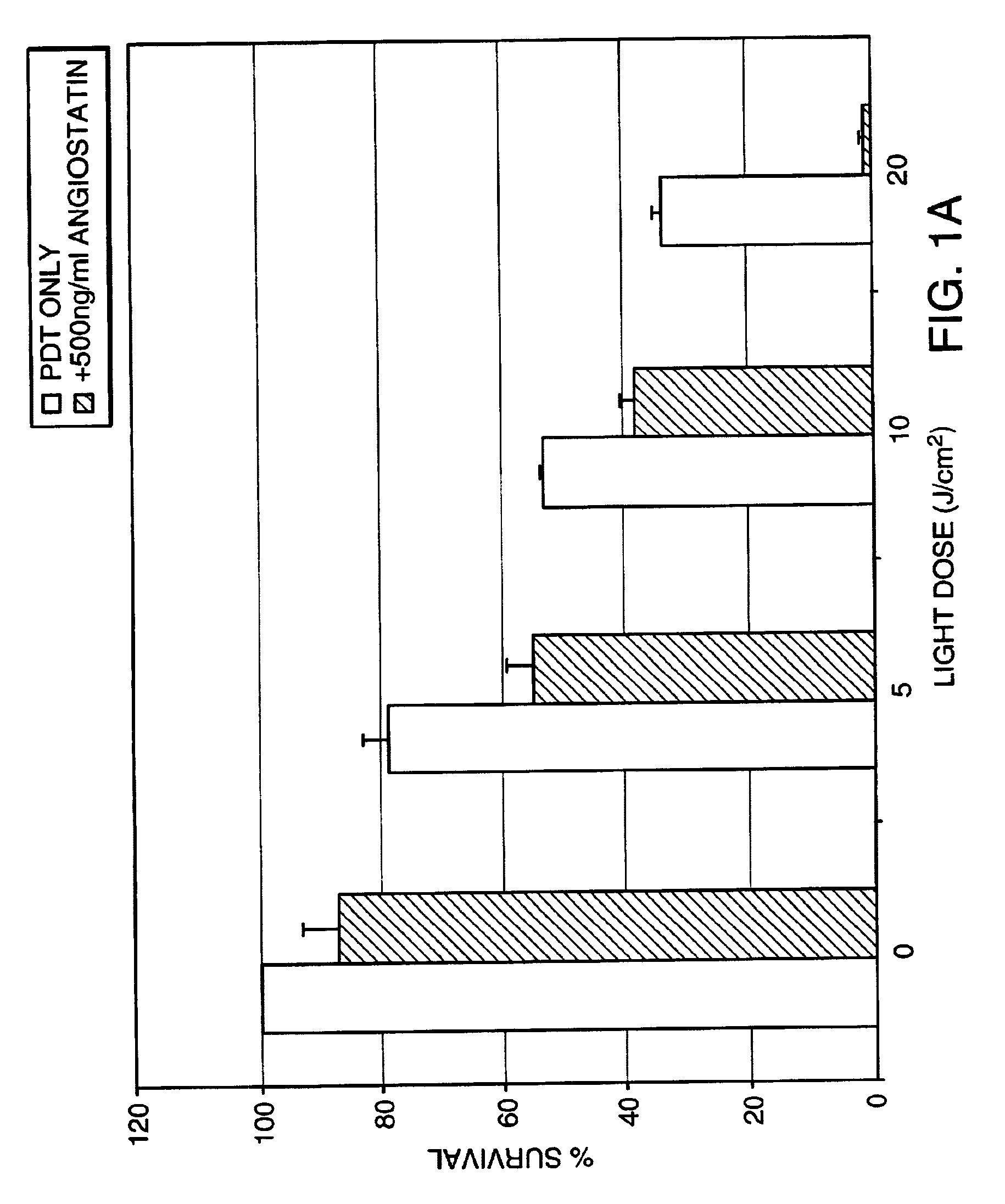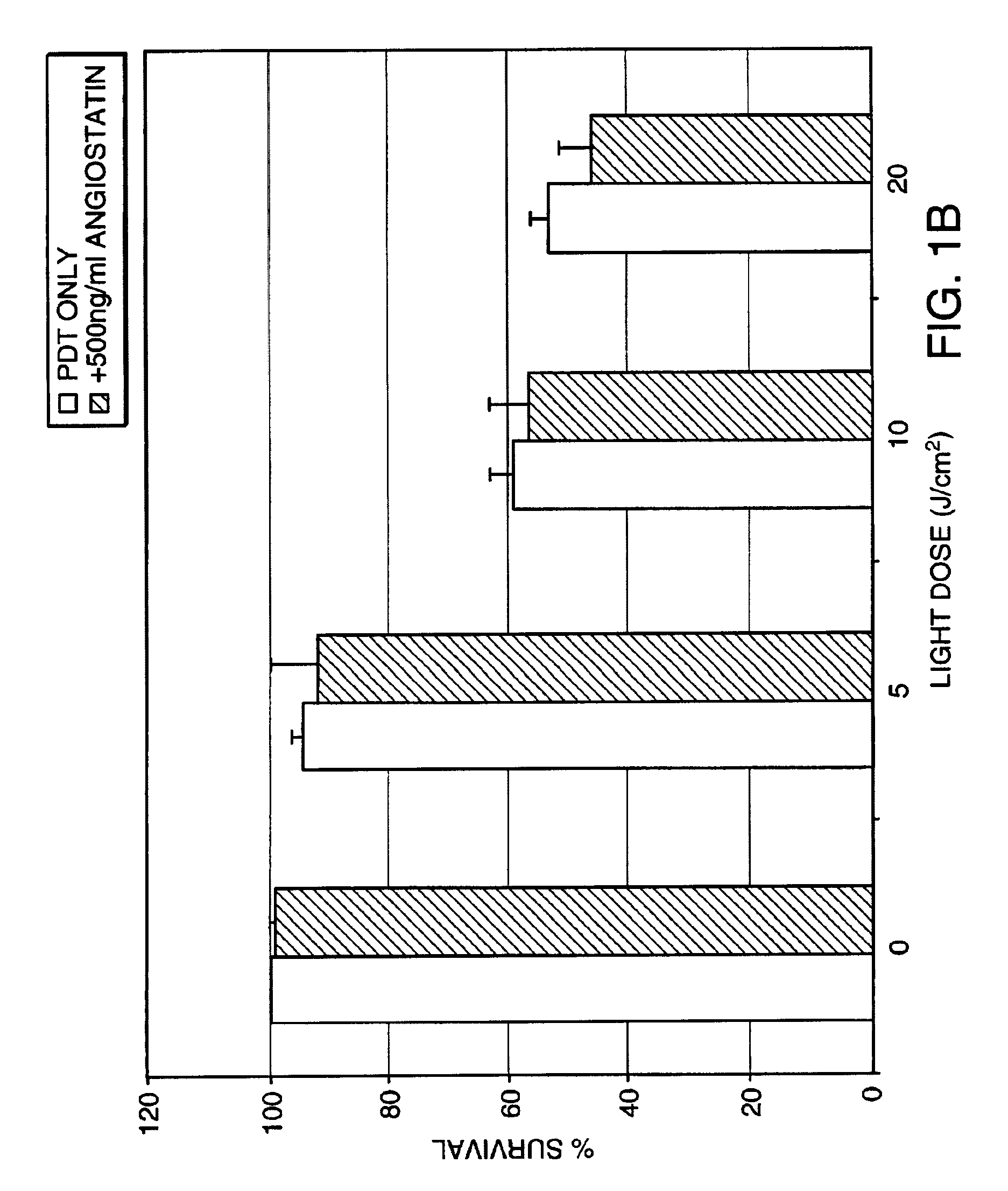Methods and compositions for treating conditions of the eye
- Summary
- Abstract
- Description
- Claims
- Application Information
AI Technical Summary
Benefits of technology
Problems solved by technology
Method used
Image
Examples
example 1
Anti-Angiogenesis Factor Potentiates the Effect of PDT on Endothelial Cells
[0073]Experiments were performed to determine whether the cytotoxicity resulting from PDT can be potentiated by the addition of an anti-angiogenesis factor. Cells of interest were treated by PDT either alone or in combination with an anti-angiogenesis factor and the effect on cytotoxicity of the PDT assessed via a cell proliferation assay.
[0074]Bovine retinal capillary endothelial (BRCE) cells (from Patricia A. D'Amore, Schepens Eye Research Institute, Boston, Mass.) and Human retinal pigment epithelial (RPE) cells (from Anthony P. Adamis, Massachusetts Eye & Ear Infirmary, Boston, Mass.) were grown at 37° C., 5% CO2 in Dulbecco's modified Eagle's medium (DMEM; Sigma, St. Louis, Mo.), 5% heat-inactivated fetal bovine serum (FBS, Gibco, Grand Island, N.Y.), supplemented with L-glutamine, penicillin, and streptomycin (Gibco Grand Island, N.Y.). Lutetium Texaphyrin (Lu-Tex) was obtained from Alcon Laboratories, ...
example 2
Cellular Morphology Following PDT with Anti-Angiogenic Factor
[0081]Experiments were performed to establish how PDT effects the cellular morphology of BRCE and RPE cells. The cells were treated and exposed to PDT either alone or in combination with angiostatin as described in Example 1. Although cells appeared severely damaged immediately after PDT, subsequent recovery occurred in certain circumstances. One week after PDT, some cells disappeared while those that remained regained their spindle shape and their ability to attach.
[0082]In BRCE cells that were first primed with angiostatin followed by PDT, widespread and massive cell death was observed at one week. Only remnants of cells and densely refractive bodies of dying cells were observed floating in the medium. Particles were recovered and placed in fresh complete media but none showed any sign of reattachment or proliferation onto a new dish. The combination of angiostatin and Lu-Tex / PDT, therefore, appears to be lethal to BRCE ...
example 3
Caspase 3-Like (DEVD-ase) Activation in BRCE and RPE Following PDT
[0084]In order to investigate the role of apoptosis in Lu-Tex / PDT mediated cell death in BRCE and RPE, the activation of Caspase 3-like (DEVD-ase) protease, a hallmark of apoptosis (Nicholson (1997) TIBS 22: 299–306), was monitored. The kinetics of activation were measured spectrofluorometrically by assaying the hydrolysis of a substrate that can be cleaved only by the caspase 3-like protease family members.
[0085]Various times after Lu-Tex / PDT, 106 cells were collected by centrifugation, and the washed cell pellet resuspended in 500 μl of ice-cold lysis buffer (pH 7.5) containing 10 mM Tris, 130 mM NaCl, 1% Triton X-100, 10 mM NaF, 10 mM NaPi, 10 mM NaPPi, 16 μg / ml benzamidine, 10 μg / ml phenanthroline, 10 μg / ml aprotinin, 10 μg / ml leupeptin, 10 μg / ml pepstatin and 4 mM 4(2-aminoethyl)-benzene-sulfanyl fluoride hydrochloride (AEBSF). Cellular lysates were stored in aliquots at −84° C. for later protease activity assay ...
PUM
 Login to View More
Login to View More Abstract
Description
Claims
Application Information
 Login to View More
Login to View More - R&D
- Intellectual Property
- Life Sciences
- Materials
- Tech Scout
- Unparalleled Data Quality
- Higher Quality Content
- 60% Fewer Hallucinations
Browse by: Latest US Patents, China's latest patents, Technical Efficacy Thesaurus, Application Domain, Technology Topic, Popular Technical Reports.
© 2025 PatSnap. All rights reserved.Legal|Privacy policy|Modern Slavery Act Transparency Statement|Sitemap|About US| Contact US: help@patsnap.com



